The Effect of Physical Faults on a Three-Shaft Gas Turbine Performance at Full- and Part-Load Operation
Abstract
:1. Introduction
2. The Development of a Gas Turbine Engine’s Performance Model
2.1. Design Point Performance Model
2.2. Off-Design Performance Model
3. Results and Discussion
Effect of Fouling and Erosion on the Gas Turbine Output Parameters
4. Conclusions
Author Contributions
Funding
Institutional Review Board Statement
Informed Consent Statement
Data Availability Statement
Acknowledgments
Conflicts of Interest
Nomenclature
| CC | Combustion chamber |
| GT | Gas turbine |
| FF | Fuel flow |
| HPT | High-pressure turbine |
| HPC | High-pressure compressor |
| ISO | International Standard Organization |
| LPC | Low-pressure compressor |
| LPT | Low-pressure turbine |
| N1 | Low-pressure speed |
| N2 | High-pressure speed |
| NGV | Nozzle guide vane |
| OEM | Original equipment manufacturer |
| PT | Power turbine |
| P24 | Exit pressure of low-pressure compressor |
| P3 | Exit pressure of high-pressure compressor |
| P43 | Exit pressure of high-pressure turbine |
| P47 | Exit pressure of low-pressure turbine |
| T24 | Exit temperature of low-pressure compressor |
| T3 | Exit temperature of high-pressure compressor |
| T5 | Exit pressure of power turbine |
| VIGV | Variable inlet guide vane |
References
- Jasmani, M.S.; Li, Y.G.; Ariffin, Z. Measurement Selections for Multicomponent Gas Path Diagnostics Using Analytical Approach and Measurement Subset Concept. J. Eng. Gas Turbines Power 2011, 133. [Google Scholar] [CrossRef]
- Roumeliotis, I.; Aretakis, N.; Alexiou, A. Industrial Gas Turbine Health and Performance Assessment with Field Data. J. Eng. Gas Turbines Power 2016, 139, 051202. [Google Scholar] [CrossRef]
- Mohammadi, E.; Montazeri-Gh, M. Simulation of Full and Part-Load Performance Deterioration of Industrial Two-Shaft Gas Turbine. J. Eng. Gas Turbines Power 2014, 136, 092602. [Google Scholar] [CrossRef]
- Molla, W.; Ambri, Z.; Karim, A.; Tesfamichael, A. Review on Gas Turbine Condition Based Diagnosis Method. Mater. Today Proc. 2021. [Google Scholar] [CrossRef]
- Zachary, J. Assessing Performance Degradation in Gas Turbines for Power Applications—A Challenging Task. In Proceedings of the GT2007 ASME Turbo Expo 2007: Power for Land, Sea and Air, Montreal, QB, Canada, 14–17 May 2007. [Google Scholar]
- Meher-Homji, C.B.; Chaker, M.A.; Motiwala, H.M. Gas Turbine Performance Deterioration. In Proceedings of the 30th Turbomachinery Symposium, Houston, TX, USA, 12–15 September 2001; pp. 17–20. [Google Scholar]
- Meher-Homji, C.B.; Matthews, T.; Pelagotti, A.; Weyermann, H.P. Gas Turbines and Turbocompressors for LNG service. In Proceedings of the 36th Turbomachinery Symposium, Houston, TX, USA, January 2007. [Google Scholar]
- Marinai, L.; Singh, R.; Curnock, B.; Probert, D. Detection and Prediction of the Performance Deterioration of a Turbofan Engine. In Proceedings of the International Gas Turbine Congress, Tokyo, Japan, 2–7 November 2003. [Google Scholar]
- Amare, D.F.; Aklilu, T.B.; Gilani, S.I. Gas Path Fault Diagnostics Using A Hybrid Intelligent Method for Industrial Gas Turbine Engines. J. Braz. Soc. Mech. Sci. Eng. 2018, 40, 578. [Google Scholar] [CrossRef]
- Tahan, M.; Muhammad, M.; Karim, Z.A.A. A Multi-Nets ANN Model for Real-Time Performance-Based Automatic Fault Diagnosis of Industrial Gas Turbine Engines. J. Braz. Soc. Mech. Sci. Eng. 2017, 39, 2865–2876. [Google Scholar] [CrossRef]
- Fentaye, A.D.; Baheta, A.T.; Gilani, S.I.; Kyprianidis, K.G. A Review on Gas Turbine Gas-Path Diagnostics: State-of-the-Art Methods, Challenges and Opportunities. Aerospace 2019, 6, 83. [Google Scholar] [CrossRef]
- Tahan, M.; Tsoutsanis, E.; Muhammad, M.; Abdul Karim, Z.A. Performance-Based Health Monitoring, Diagnostics and Prognostics for Condition-Based Maintenance of Gas Turbines: A Review. Appl. Energy 2017, 198, 122–144. [Google Scholar] [CrossRef]
- Urban, L.A. Gas Turbine Engine Parameter Interrelationships, 2nd ed.; Hamilton Standard Division of United Aircraft Corporation: Windsor Locks, CT, USA, 1969. [Google Scholar]
- Talebi, S.S.; Tousi, A.M. The Effects of Compressor Blade Roughness on the Steady State Performance of Micro-Turbines. Appl. Therm. Eng. 2017, 115, 517–527. [Google Scholar] [CrossRef]
- Kang, D.W.; Kim, T.S. Model-Based Performance Diagnostics of Heavy-Duty Gas Turbines Using Compressor Map Adaptation. Appl Energy 2018, 212, 1345–1359. [Google Scholar] [CrossRef]
- Orozco, D.J.R.; Venturini, O.J.; Escobar Palacio, J.C.; del Olmo, O.A. A New Methodology of Thermodynamic Diagnosis, Using the Thermo-economic Method Together with An Artificial Neural Network (ANN): A Case Study of An Externally Fired Gas Turbine (EFGT). Energy 2017, 123, 20–35. [Google Scholar] [CrossRef]
- Salilew, W.M.; Karim, Z.A.A.; Lemma, T.A. Investigation of Fault Detection and Isolation Accuracy of Different Machine Learning Techniques with Different Data Processing Methods for Gas Turbine. Alex. Eng. J. 2022, 61, 12635–12651. [Google Scholar] [CrossRef]
- Salilew, W.M.; Karim, Z.A.A.A.; Lemma, T.A.; Fentaye, A.D.; Kyprianidis, K.G. Predicting the Performance Deterioration of a Three-Shaft Industrial Gas Turbine. Entropy 2022, 24, 1052. [Google Scholar] [CrossRef]
- Ying, Y.; Cao, Y.; Li, S.; Li, J.; Guo, J. Study on Gas Turbine Engine Fault Diagnostic Approach with a Hybrid of Gray Relation Theory and Gas-Path Analysis. Adv. Mech. Eng. 2016, 8, 1–14. [Google Scholar] [CrossRef]
- Colera, M.; Soria, Á.; Ballester, J. A Numerical Scheme for the Thermodynamic Analysis of Gas Turbines. Appl. Therm. Eng. 2019, 147, 521–536. [Google Scholar] [CrossRef]
- Saravanamuttoo, H.I.; Rogers, G.F.C.; Cohen, H. Gas Turbine Theory, 7th ed.; Pearson Education: London, UK, 2017. [Google Scholar]
- Chen, Q.; Han, W.; Zheng, J.J.; Sui, J.; Jin, H.G. The Exergy and Energy Level Analysis of A Combined Cooling, Heating and Power System Driven by A Small-Scale Gas Turbine at Off Design Condition. Appl. Therm. Eng. 2014, 66, 590–602. [Google Scholar] [CrossRef]
- Huang, Y.; Turan, A. Mechanical Equilibrium Operation Integrated Modelling of Hybrid SOFC—GT Systems: Design Analyses and Off-design Optimization. Energy 2020, 208, 118334. [Google Scholar] [CrossRef]
- Cao, Y.; Dai, Y. Comparative Analysis on Off-design Performance of A Gas Turbine and ORC Combined Cycle Under Different Operation Approaches. Energy Convers. Manag. 2017, 135, 84–100. [Google Scholar] [CrossRef]
- Lee, J.J.; Kang, D.W.; Kim, T.S. Development of A Gas Turbine Performance Analysis Program and Its Application. Energy 2011, 36, 5274–5285. [Google Scholar] [CrossRef]
- Kurzke, J. Simplifications in Gas Turbine Performance Calculations. In Proceedings of the GT2007, ASME Turbo Expo 2007: Power for Land, Sea and Air, Dachau, Germany, 14–17 May 2007. [Google Scholar]
- Stamatis, A.; Papailiou, A. Adaptive Simulation of Gas Turbine Performance; American Society of Mechanical Engineers: New York, NY, USA, 1989. [Google Scholar]
- Mattingly, J.D.; Heiser, W.H.; Pratt, D.T. Aircraft Engine Design, 2nd ed.; AIAA: Reston, VA, USA, 2002. [Google Scholar]
- Gmbh, G. GasTurb 13 Design and Off-Design Performance of Gas Turbines, GasTurb. Dachau, Germany. 2018. Available online: https://gasturb.de (accessed on 2 August 2022).
- Tsoutsanis, E.; Meskin, N.; Benammar, M.; Khorasani, K. A Component Map Tuning Method for Performance Prediction and Diagnostics of Gas Turbine Compressors. Appl. Energy 2014, 135, 572–585. [Google Scholar] [CrossRef] [Green Version]
- Al-Hamdan, Q.Z.; Ebaid, M.S. Modeling and Simulation of a Gas Turbine Engine for Power Generation. J. Eng. Gas Turbines Power 2005, 128, 302–311. [Google Scholar] [CrossRef]
- Haglind, F.; Elmegaard, B. Methodologies for Predicting the Part-load performance of Aero-Derivative Gas Turbines. Energy 2009, 34, 1484–1492. [Google Scholar] [CrossRef]
- Song, Y.; Gu, C.; Ji, X. Development and Validation of a Full-Range Performance Analysis Model for a Three-Spool Gas Turbine with Turbine Cooling. Energy 2015, 89, 545–557. [Google Scholar] [CrossRef]
- Kim, J.H.; Kim, T.S. A New Approach to Generate Turbine Map Data in the Sub-Idle Operation Regime of Gas Turbines. Energy 2019, 173, 772–784. [Google Scholar] [CrossRef]
- Hashmi, M.B.; Majid, M.A.A.; Lemma, T.A. Combined Effect of Inlet Air Cooling and Fouling on Performance of Variable Geometry Industrial Gas Turbines. Alex. Eng. J. 2020, 59, 1811–1821. [Google Scholar] [CrossRef]
- Sanaye, S.; Hosseini, S. Off-Design Performance Improvement of Twin-Shaft Gas Turbine by Variable Geometry Turbine and Compressor Besides Fuel Control. Proc. Inst. Mech. Eng. Part A J. Power Energy 2019, 234, 957–980. [Google Scholar] [CrossRef]
- Merrington, G.; Kwon, O.K.; Goodwin, G.; Carlsson, B. Fault Detection and Diagnosis in Gas Turbines. In Proceedings of the ASME Turbo Expo 5, Brussels, Belgium, 11–14 June 1990. [Google Scholar]
- Chen, Y.Z.; Zhao, X.D.; Xiang, H.C.; Tsoutsanis, E. A Sequential Model-Based Approach for Gas Turbine Performance Diagnostics. Energy 2020, 220, 119657. [Google Scholar] [CrossRef]
- Diakunchak, I.S. Performance Deterioration in Industrial Gas Turbines. In Proceedings of the ASME Turbo Expo, Orlando, FL, USA, 3–6 June 1991. [Google Scholar]
- Escher, P.C. Pythia: An Object-Orientated Gas Path Analysis Computer Program for General Applications. Ph.D. Thesis, Cranfield University, Cranfield, UK, 1995; p. 229. [Google Scholar]
- Macleod, J.D.; Staff, V.T.; Laflamme, J.C.G. Implanted Component Faults and Their Effects on Gas Turbine Engine Performance. In Proceedings of the ASME 1991 International Gas Turbine and Aeroengine Congress and Exposition, Orlando, FL, USA, 3–6 June 2022. [Google Scholar]
- Aker, G.F.; Saravanamuttoo, H.I.H. Predicting Gas Turbine Performance Degradation Due to Compressor Fouling Using Computer Simulation Techniques. J. Eng. Gas Turbines Power 1989, 111, 343–350. [Google Scholar] [CrossRef]
- Saravanamuttoo, H.I.H.; Maclsaac, B.D. Thermodynamic Models for Pipeline Gas Turbine Diagnostics. ASME 1983, 105, 875–884. [Google Scholar]
- Boyce, M.P.; Meher-Homji, C.B.; Lakshminarasimha, A.N. Modeling and Analysis of Gas Turbine Performance Deterioration. ASME 1994, 116, 46–52. [Google Scholar]
- Qingcai, Y.; Cao, Y.; Li, S.; Zhao, N. Full and Part-Load Performance Deterioration Analysis of Industrial Three-Shaft Gas Turbine Based on Genetic Algorithm. In Proceedings of the ASME Turbo Expo 2016: Turbomachinery Technical Conference and Exposition GT2016, Seoul, Korea, 13–17 June 2016. [Google Scholar]
- Muir, D.E.; Saravanamuttoo, H.I.H.; Marshall, D.J. Health Monitoring of Variable Geometry Gas Turbines for the Canadian Navy. ASME 1989, 111, 244–250. [Google Scholar] [CrossRef]
- Razak, A.M.Y. Gas turbine performance modelling, analysis and optimization. In Modern Gas Turbine Systems; Woodhead Publishing Limited: Sawston, UK, 2013. [Google Scholar]
- Kurzke, J. Advanced User-Friendly Gas Turbine Performance Calculations On A Personal Computer. In Proceedings of the ASME 1995 International Gas Turbine and Aeroengine Congress and Exposition, Houston, TX, USA, 5–8 June 1995. [Google Scholar]
- Kurkz. Design-Point Calculations of Industrial Gas Turbines. pp. 376–397. Available online: https://asmedigitalcollection.asme.org/ebooks/book/251/chapter-abstract/25382060/Design-Point-Calculations-of-Industrial-Gas?redirectedFrom=fulltext (accessed on 2 August 2022).
- Ao, S.I.; Gelman, L.; Hukins, D.W.L.; Hunter, A.; Korsunsky, A.; International Association of Engineers. Design and Off-Design Operation and Performance Analysis of a Gas Turbine. In Proceedings of the World Congress on Engineering, Vol II WCE 2018, London, UK, 4–6 July 2018. [Google Scholar]
- Hashmi, M.B.; Lemma, T.A.; Karim, Z.A.A. Investigation of the combined effect of variable inlet guide vane drift, fouling, and inlet air cooling on gas turbine performance. Entropy 2019, 21, 1186. [Google Scholar] [CrossRef] [Green Version]






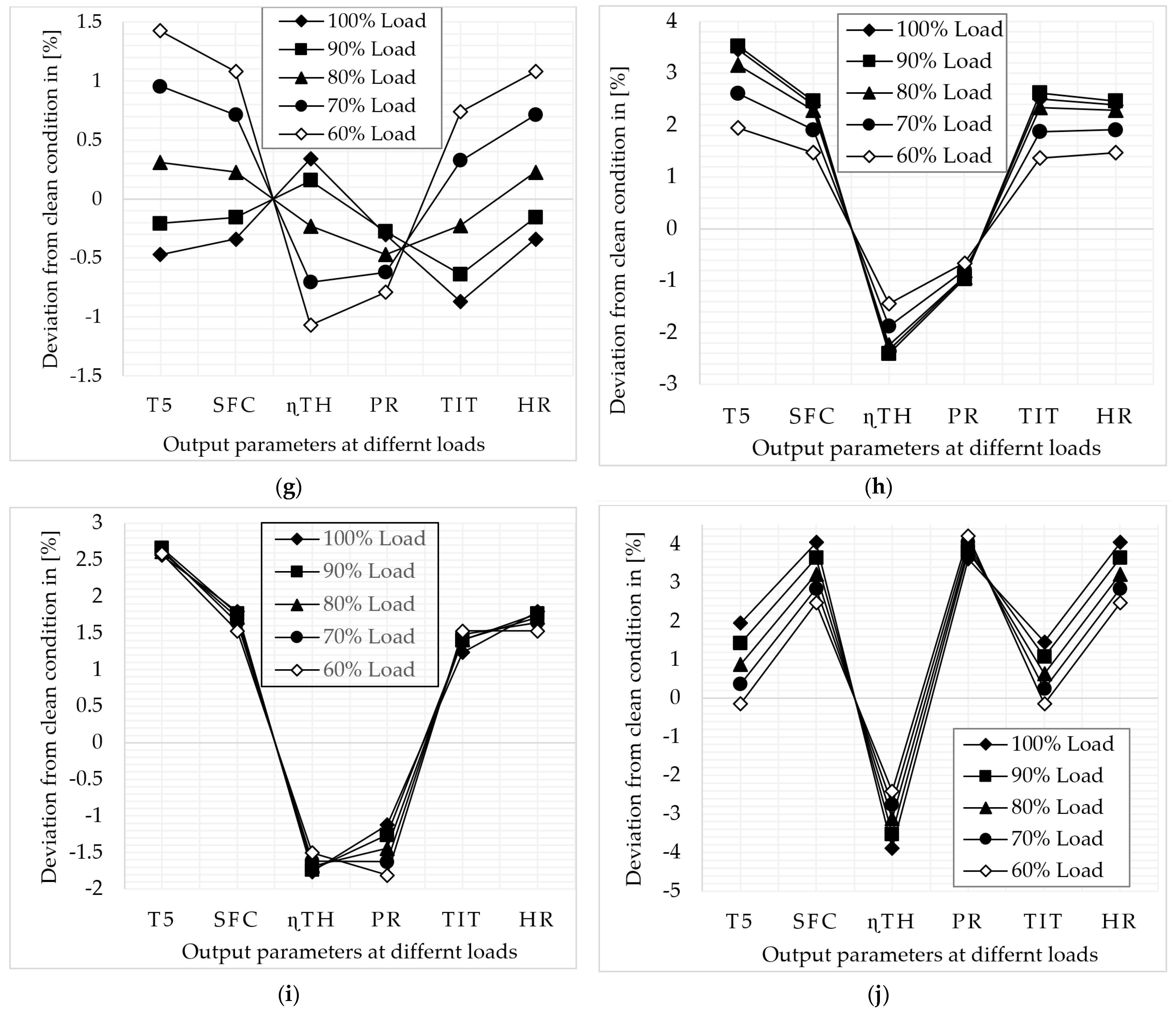

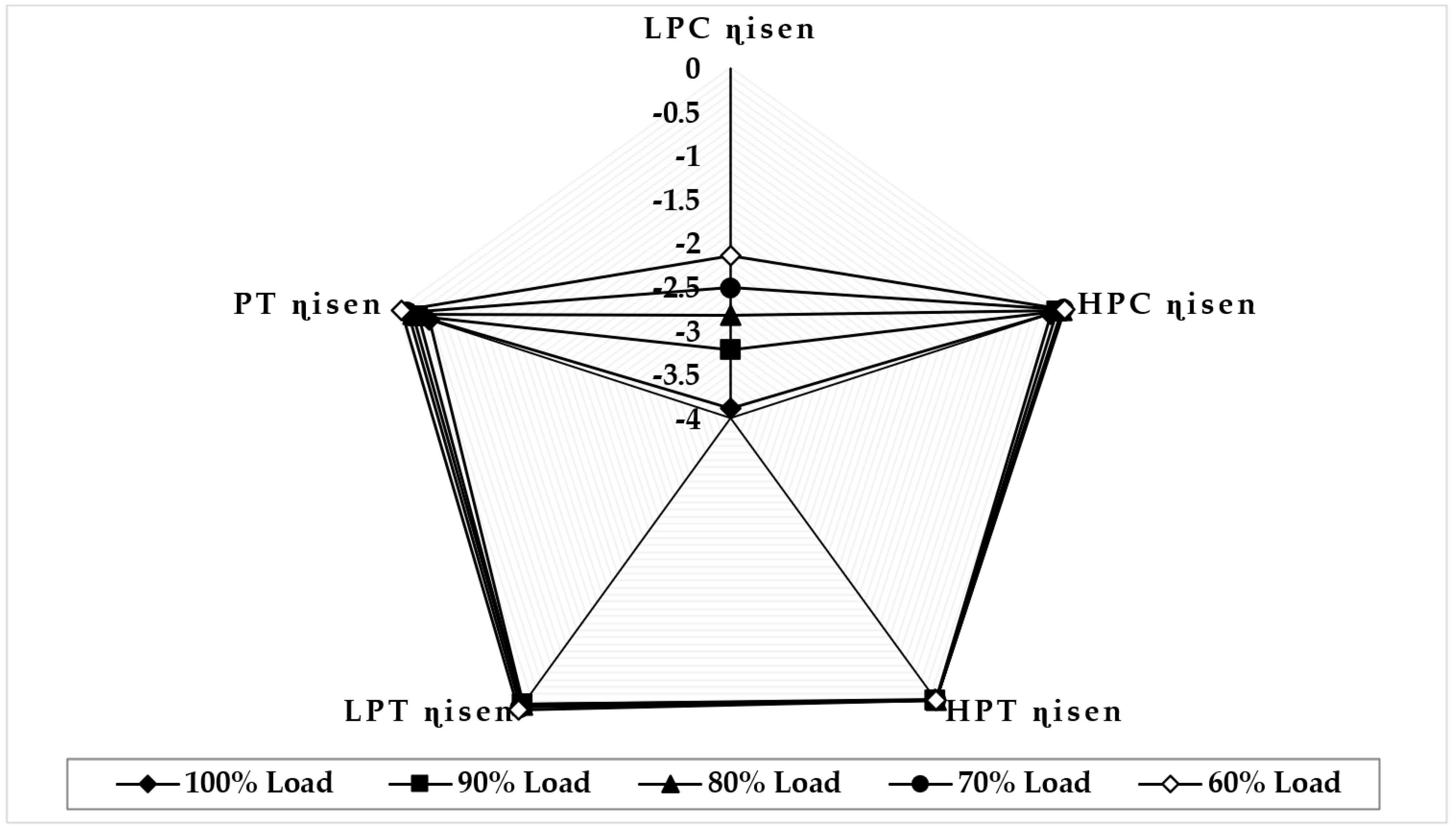

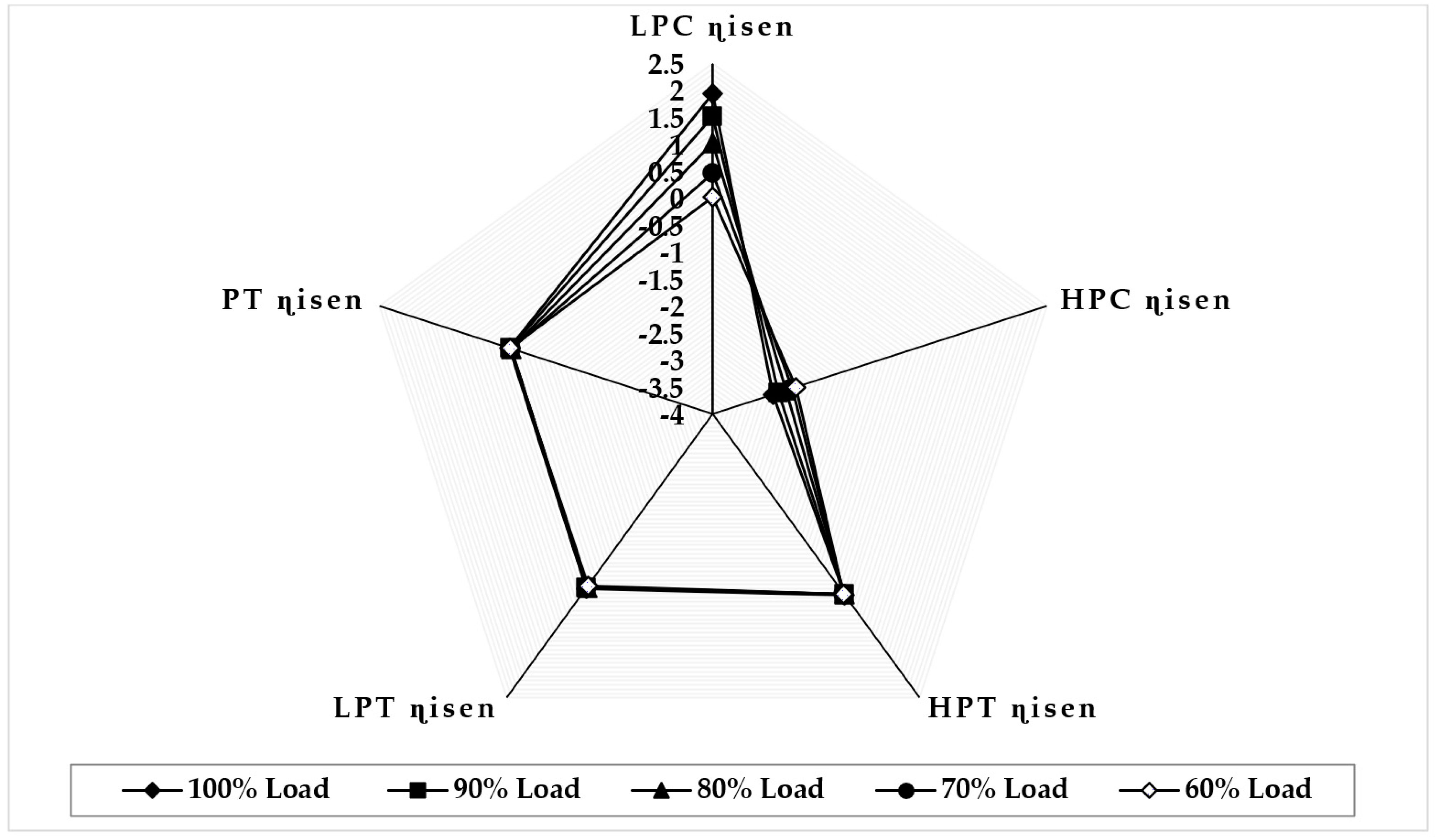
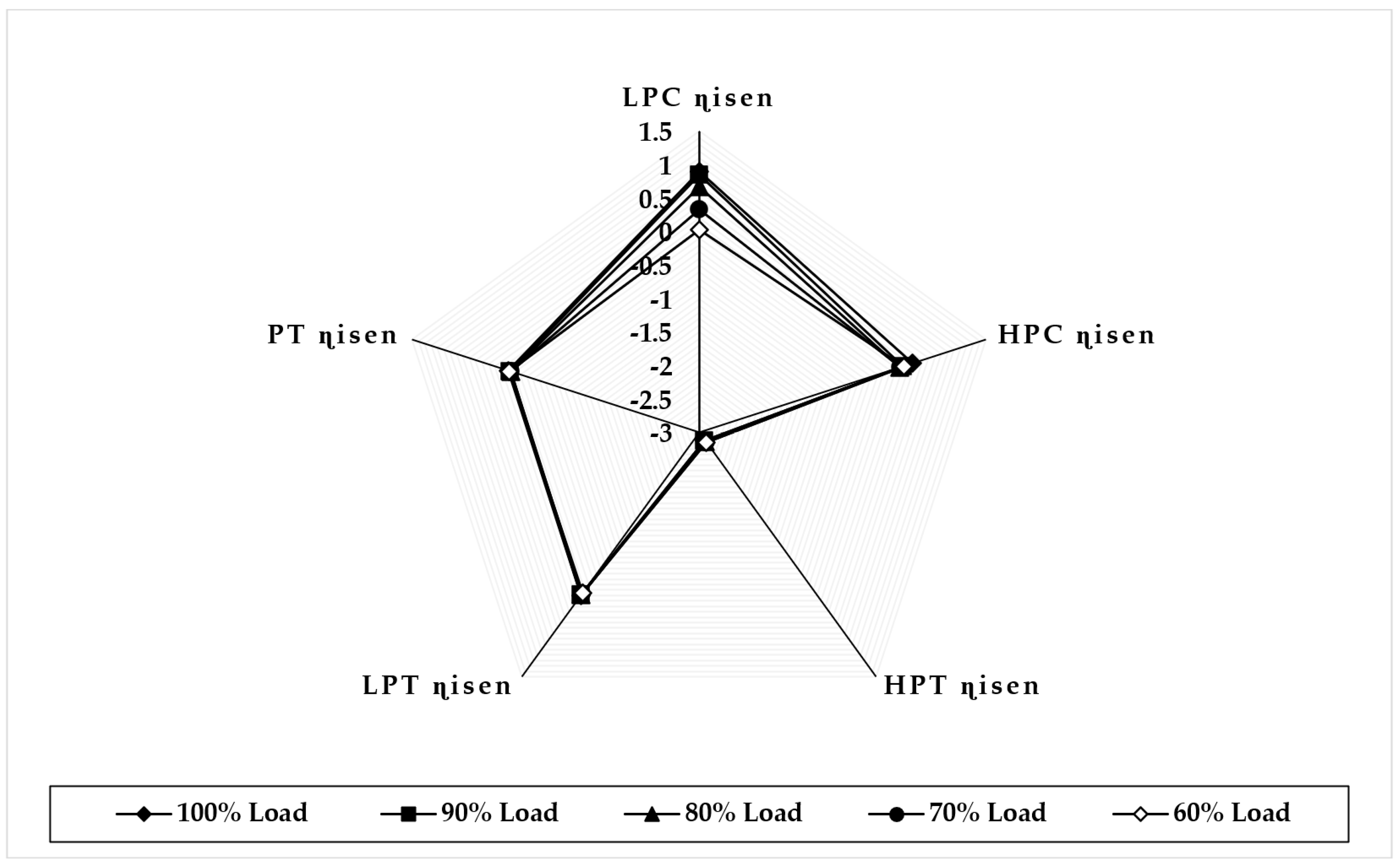
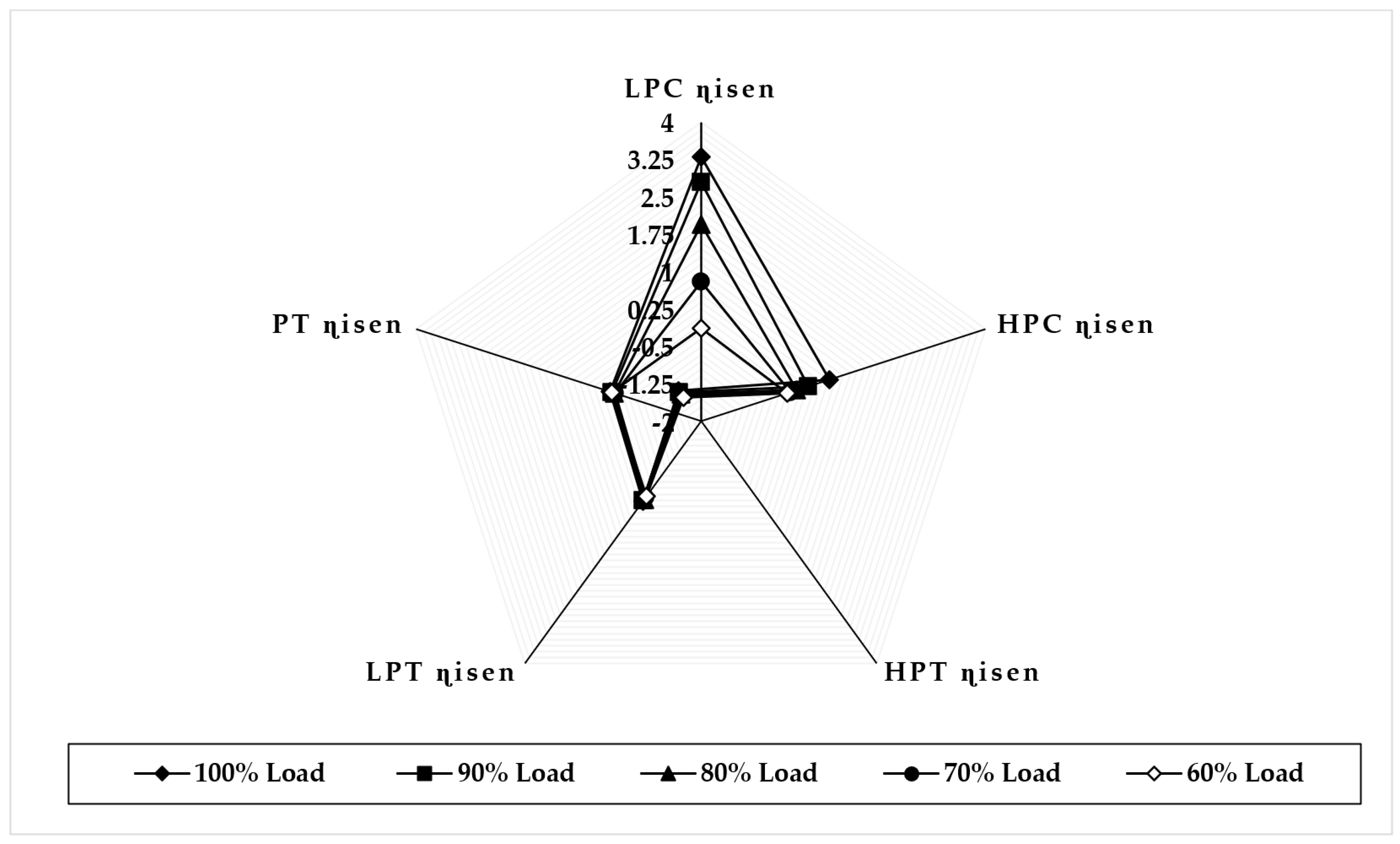

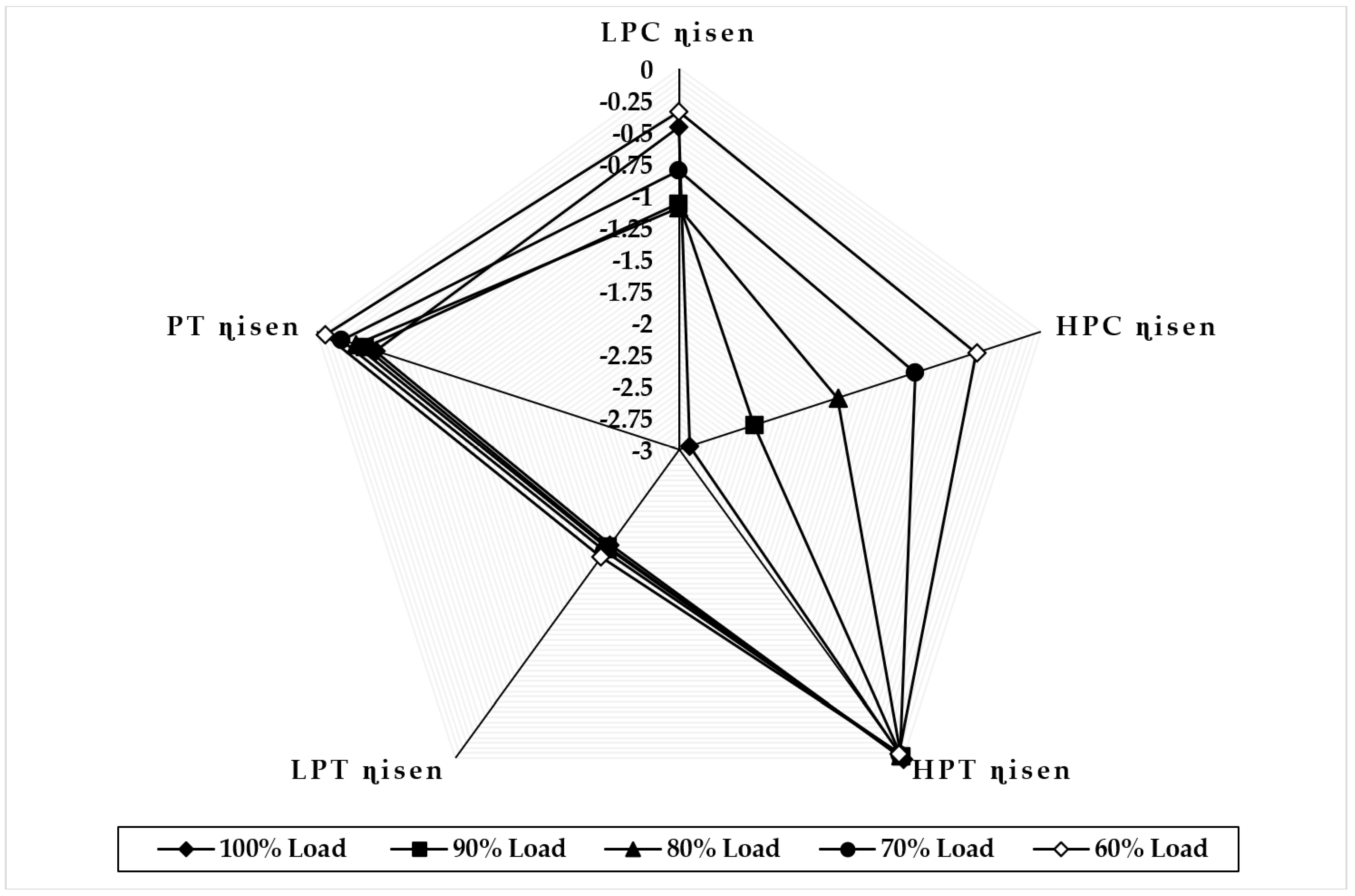
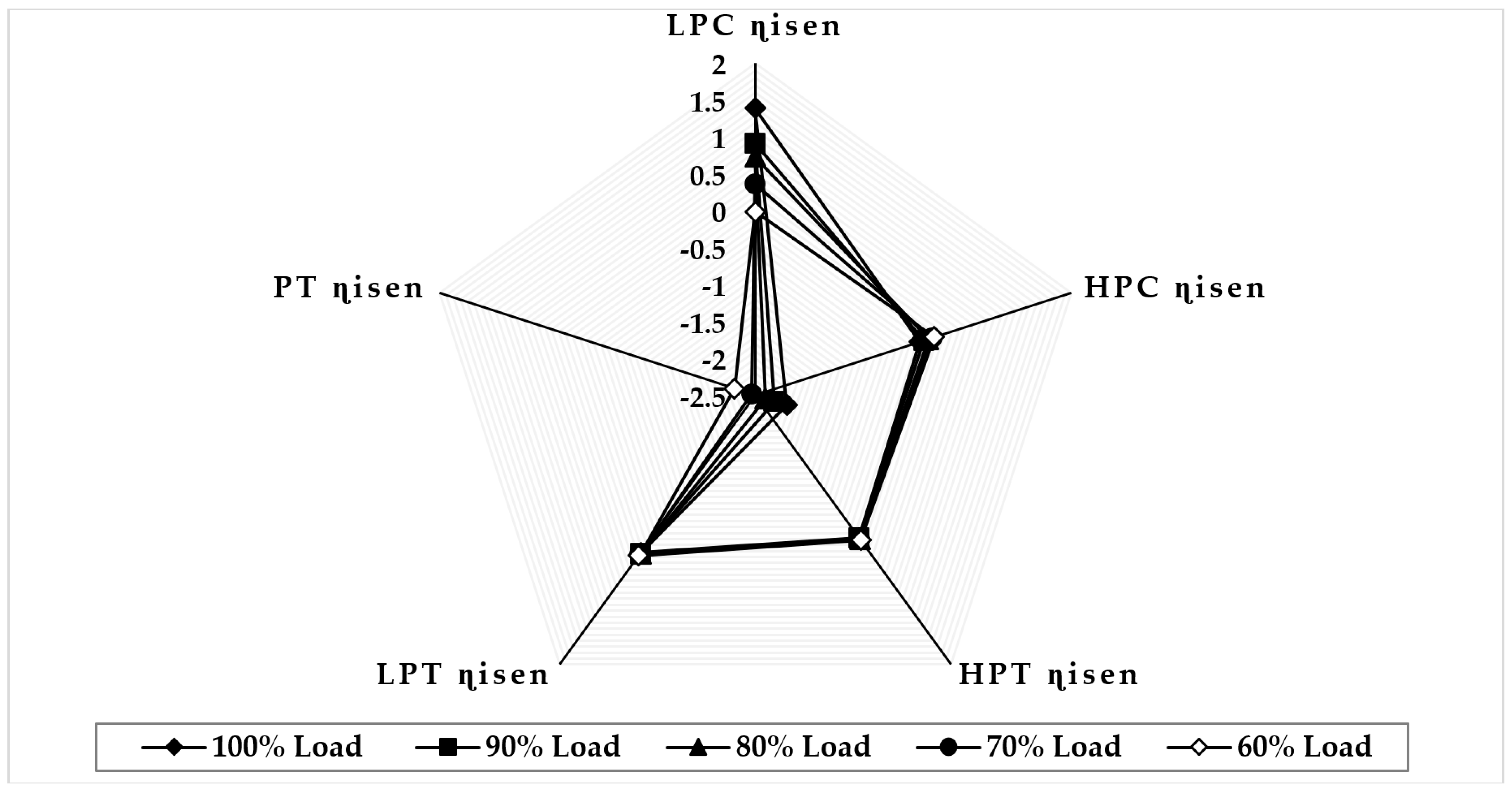
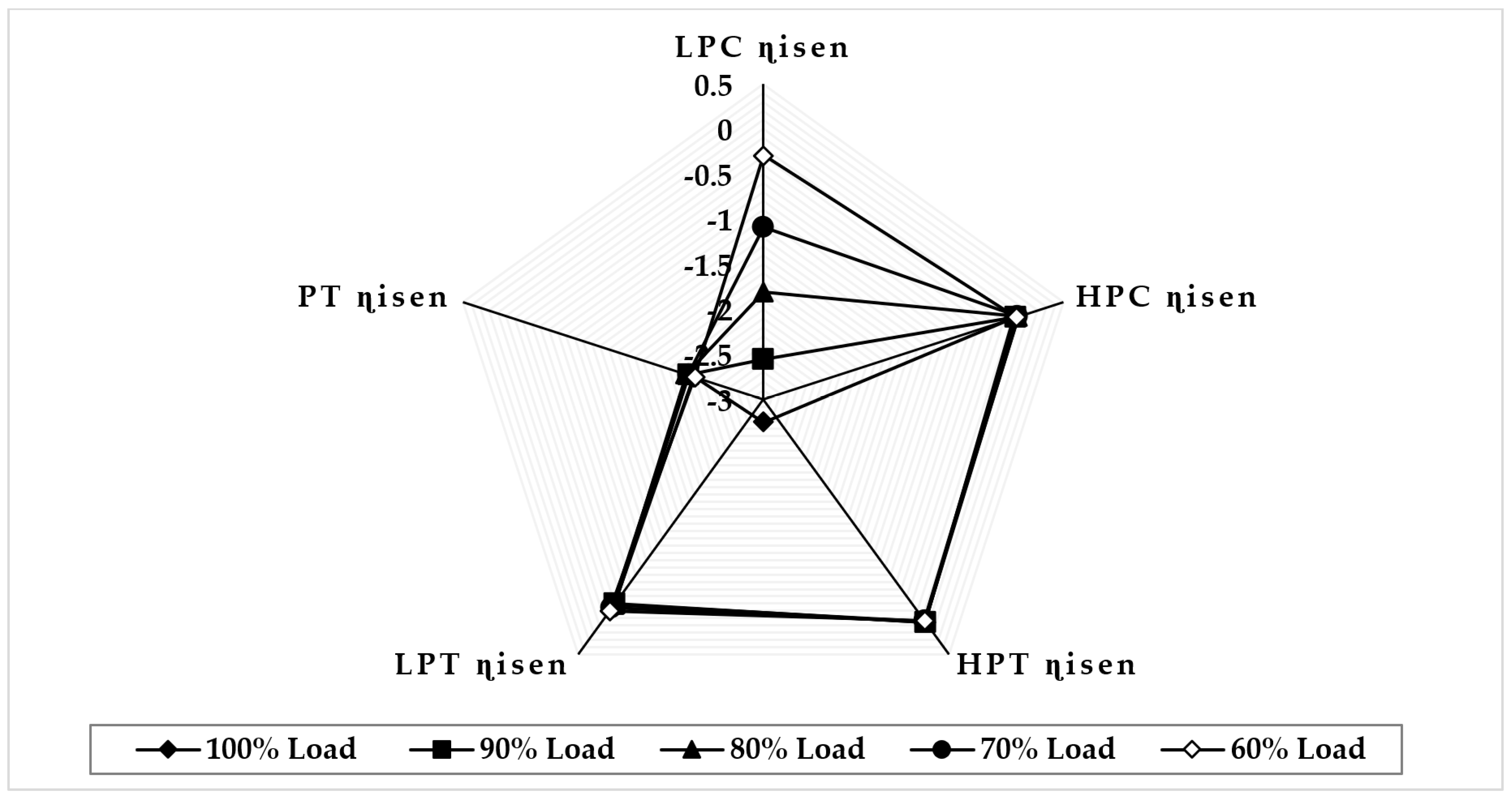
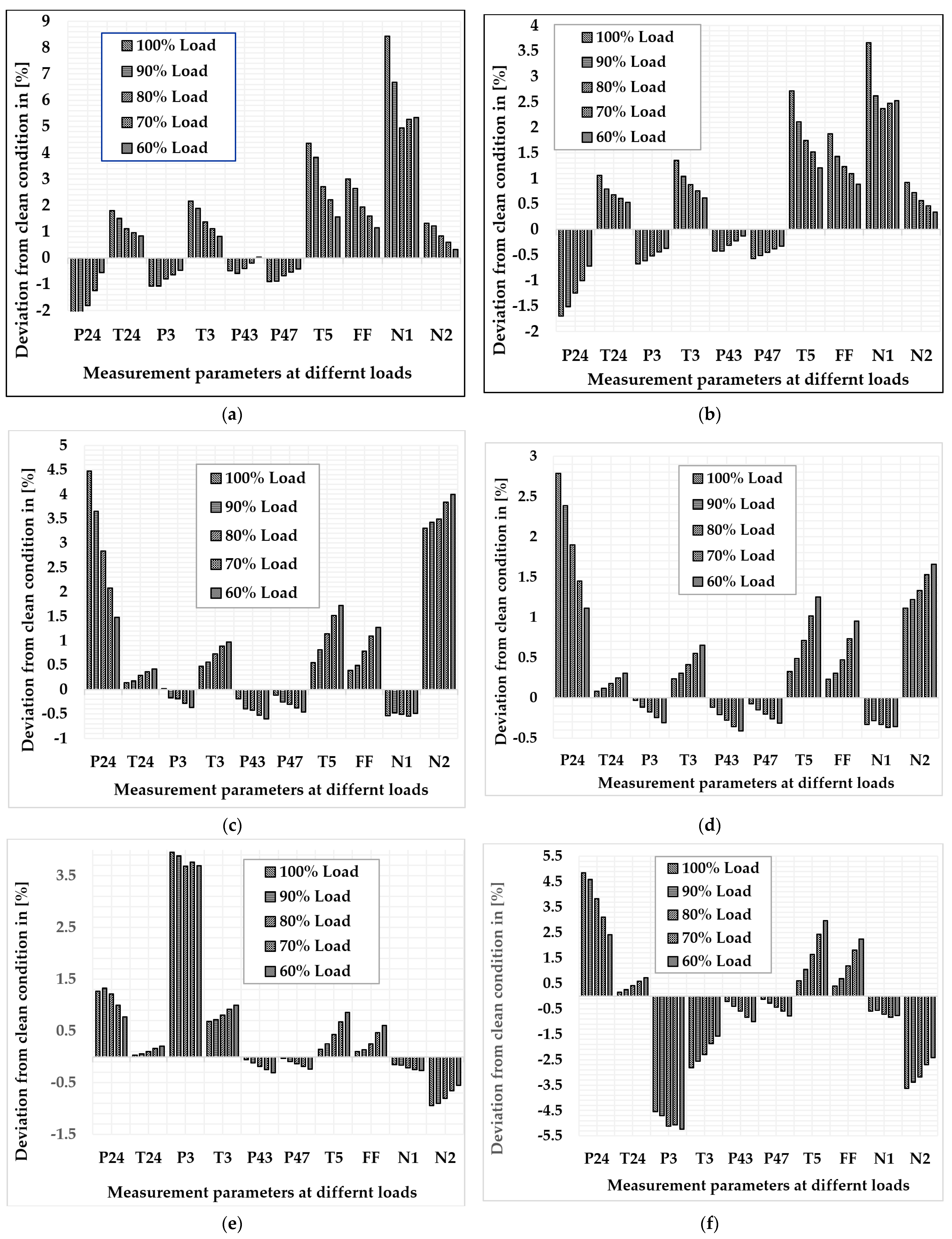


| Parameter | Unit | Value | Source |
|---|---|---|---|
| Power output | MW | 26.025 | OEM document |
| Pressure ratio | - | 20:01 | OEM document |
| Thermal efficiency | % | 35.8 | OEM document |
| Exhaust mass flowrate | Kg/s | 92.2 | OEM document |
| Heat rate | KJ/KWh | 10043 | OEM document |
| Turbine inlet temp. | °C | 1193 | [1] |
| Exhaust temperature | °C | 488 | OEM document |
| LPC rotational speed | RPM | 6643 | OEM document |
| HPC rotational speed | RPM | 9445 | OEM document |
| FPT rotational speed | RPM | 4950 | OEM document |
| LPC stages | - | 7 | OEM document |
| HPC stages | - | 6 | OEM document |
| HPT stages | - | 1 | OEM document |
| LPT stages | - | 1 | OEM document |
| FPT stages | - | 2 | OEM document |
| Constraints | Min Value | Optimized Values | Max Value |
|---|---|---|---|
| Overall thermal efficiency (%) | 33 | 35.85 | 41 |
| Heat rate (KJ/KWh) | 8853 | 10,040.2 | 10,043.5 |
| Exhaust Temperature (°C) | 460 | 479.076 | 496.7 |
| Variables | Minimum Value | Optimized Value | Maximum Value |
|---|---|---|---|
| HPT NGV1 Cooling air | 0.04 | 0.061 | 0.065 |
| HPT Rotor 1 Cooling air | 0.03 | 0.051 | 0.054 |
| IPT NGV 1 Cooling air | 0.008 | 0.021 | 0.025 |
| IPT NGV 1 Cooling air | 0.008 | 0.021 | 0.025 |
| Exhaust pressure ratio | 1 | 1.1620 | 1.2 |
| IPC Isentropic Efficiency | 0.9 | 0.9 | 0.95 |
| HPC Isentropic Efficiency | 0.9 | 0.85 | 0.95 |
| HPT Isentropic Efficiency | 0.89 | 0.8977 | 0.93 |
| LPT Isentropic Efficiency | 0.91 | 0.9125 | 0.94 |
| PT Isentropic Efficiency | 0.89 | 0.8963 | 0.92 |
| Parameter | Value |
|---|---|
| Power output (KW) | 26,025 |
| Parameter | Units | OEM Data | GasTurb13 Model | % Error |
|---|---|---|---|---|
| Power Output | kW | 26,025 | 26,025.5 | 0.0019 |
| Thermal Efficiency | % | 35.8 | 35.8 | 0 |
| Pressure Ratio | - | 20:1 | 20:1 | 0 |
| Fuel Flowrate Lower Heating Value | kg/s MJ/kg | - - | 1.53281 47.16 | - - |
| Exhaust Temperature | °C | 488 | 479.5 | 1.116 |
| Turbine Inlet Temperature | °C | 1193 | 1193 | 0 |
| Heat Rate | kJ/(kWh) | 10,043 | 10,040.2 | 0.027 |
| Low-Pressure Spool | Intermediate Pressure Spool | High-Pressure Spool | |
|---|---|---|---|
| Absolute [RPM] | 4950.0 | 6643.0 | 9445.0 |
| Relative | 1.0000 | 1.0000 | 1.0000 |
| Low-Pressure Compressor Map | Low-Pressure Compressor Map |
|---|---|
| 56.467 | 24.104 |
| LPC | HPC | HPT | IPT | PT | |
|---|---|---|---|---|---|
| Map relative Speed | 1.0000 | 1.0000 | 1.0000 | 1.0000 | 1.0000 |
| Map Coordinate Beta | 0.4000 | 0.5000 | 0.5000 | 0.5000 | 0.7000 |
| Physical Fault | Flow Capacity Change (A) | Isentropic Efficiency Change (B) | Ratio A:B | Range |
|---|---|---|---|---|
| Compressor fouling | ΓC↓ | ηC↓ | 3:1 | (0, −7.5%) (0, −2.5%) |
| Compressor erosion | ΓC↓ | ηC↓ | 2:1 | (0, −4%) (0, −2%) |
| Turbine fouling | ΓT↓ | ηT↓ | 2:1 | (0, −4%) (0, −2%) |
| Turbine erosion | ΓT↓ | ηT↓ | 2:1 | (0, +4%) (0, −2%) |
Publisher’s Note: MDPI stays neutral with regard to jurisdictional claims in published maps and institutional affiliations. |
© 2022 by the authors. Licensee MDPI, Basel, Switzerland. This article is an open access article distributed under the terms and conditions of the Creative Commons Attribution (CC BY) license (https://creativecommons.org/licenses/by/4.0/).
Share and Cite
Salilew, W.M.; Abdul Karim, Z.A.; Lemma, T.A.; Fentaye, A.D.; Kyprianidis, K.G. The Effect of Physical Faults on a Three-Shaft Gas Turbine Performance at Full- and Part-Load Operation. Sensors 2022, 22, 7150. https://doi.org/10.3390/s22197150
Salilew WM, Abdul Karim ZA, Lemma TA, Fentaye AD, Kyprianidis KG. The Effect of Physical Faults on a Three-Shaft Gas Turbine Performance at Full- and Part-Load Operation. Sensors. 2022; 22(19):7150. https://doi.org/10.3390/s22197150
Chicago/Turabian StyleSalilew, Waleligne Molla, Zainal Ambri Abdul Karim, Tamiru Alemu Lemma, Amare Desalegn Fentaye, and Konstantinos G. Kyprianidis. 2022. "The Effect of Physical Faults on a Three-Shaft Gas Turbine Performance at Full- and Part-Load Operation" Sensors 22, no. 19: 7150. https://doi.org/10.3390/s22197150





